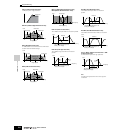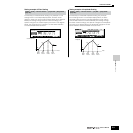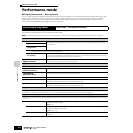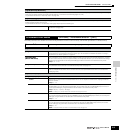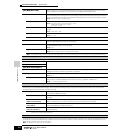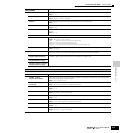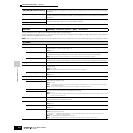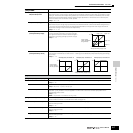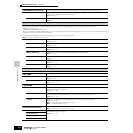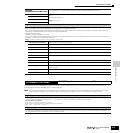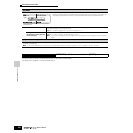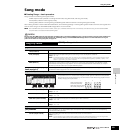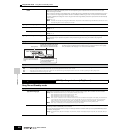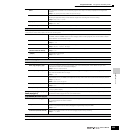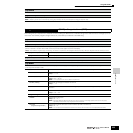
Reference Performance Mode
Performance Edit mode Part Edit
218
Owner’s Manual
[SF3] SELECT (Output Select)
From this display you can assign individual Parts to sound from independent output connectors (jacks).
OutputSel (Output Select) Determines the specific output(s) for the individual Part. You can assign each individual Part’s Voice to be output
from a specific hardware output jack on the rear panel.
Settings: See page 31.
InsEF (Insertion Effect) Determines whether the Insertion effects are applied to individual Parts or not.
Settings: on, off
[F3] EQ (Equalizer)
From this display you can adjust the EQ settings for each Part. Note that two different display types listed below are provided and you can switch between them
by pressing the [SF5] button. Each display type features the same settings in a different format; use the type you feel most comfortable with.
• Display showing four Parts
• Display showing all parameters for one Part
Keep in mind that since all the available parameters cannot be simultaneously displayed in the four-Part display, you will need to use the cursor controls to scroll
the display in order to see and set the other parameters.
For details about the Effect connection including the EQ in the Performance mode, see page 179.
n This display is not available for the Plug-in Part.
LowFreq (Low Frequency) Determines the center frequency of the low EQ band that is attenuated/boosted.
Settings: 50.1 ~ 2.00K
LowGain (Low Gain) Determines the amount of boost or attenuation applied to the low EQ band.
Settings: -32 ~ +32
MidFreq (Middle Frequency) Determines the center frequency of the middle EQ band that is attenuated/boosted.
Settings: 139.7 ~ 10.1K
MidGain (Middle Gain) Determines the amount of boost or attenuation applied to the middle EQ band.
Settings: -32 ~ +32
MidReso (Middle Resonance) Determines the resonance applied to the center frequency of the middle EQ band.
Settings: 0 ~ 31
HighFreq (High Frequency) Determines the center frequency of the high EQ band that is attenuated/boosted.
Settings: 503.8 ~ 14.0K
HighGain (High Gain) Determines the amount of boost or attenuation applied to the high EQ band.
Settings: -32 ~ +32
[F4] TONE
You can set parameters related to the pitch and tone for each Part. Keep in mind that the settings made here are applied as offsets to the Voice Edit settings.
[SF1] TUNE
NoteShift Determines the pitch (key transpose) setting for each Part in semitones.
Settings: -24 ~ +24
Detune Determines the fine tuning for each Part.
Settings: -12.8Hz ~+12.7Hz
[SF2] FILTER
Cutoff Determines the cutoff frequency for each Part. This parameter is available for the LPF when the filter used by the Part
is a combination type of LPF and HPF.
Settings: -64 ~ 0 ~ +63
Resonance Determines the amount of filter resonance or emphasis of the Cutoff Frequency for each Part. The setting here
attenuates/boosts the resonance applied to the element of the Voice assigned to each Part.
Settings: -64 ~ 0 ~ +63
FEGDepth Determines the Filter Envelope Generator depth (amount of cutoff frequency) for each Part.
Settings: -64 ~ 0 ~ +63
n The FEG Depth setting is not available for the Plug-in Parts.
n For details about Filter, see page 161.
[SF3] FEG
(Filter Envelope Generator)
From this display you can set the FEG (Filter Envelope Generator) parameters for each Part.
n The FEG settings are not available for Plug-in Parts.
Attack (Attack Time) Determines each parameter of the FEG for each Part.
For details about FEG, see page 161.
Settings: -64 ~ 0 ~ +63
Decay (Decay Time)
Sustain (Sustain Level)
Release (Release Level)



